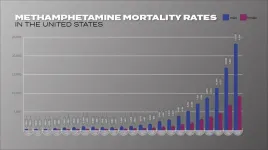(Press-News.org) Embargoed for release until 5:00 p.m. ET on Monday 13 January 2025
@Annalsofim
Below please find summaries of new articles that will be published in the next issue of Annals of Internal Medicine. The summaries are not intended to substitute for the full articles as a source of information. This information is under strict embargo and by taking it into possession, media representatives are committing to the terms of the embargo not only on their own behalf, but also on behalf of the organization they represent.
----------------------------
1. Travel distance to nearest lung cancer facility differs by racial and ethnic makeup of communities
American Indian/Alaska Native populations are 5 times further away from lung cancer screening centers than non-Hispanic White populations.
Abstract: https://www.acpjournals.org/doi/10.7326/M24-0124
URL goes live when the embargo lifts
A cross-sectional ecological study found that there are differences in travel distance to lung cancer screening (LCS) facilities by race and ethnicity, but those differences are only partially explained by rurality. According to the study authors, these findings could inform the placement of future imaging locations and mobile units for LCS to increase equitable access to LCS services. The results are published in Annals of Internal Medicine.
Researchers from Washington State University and Swedish Cancer Institute studied data from 71,691 U.S. census tracts (2,500-8,000 people) to examine race-, ethnicity-, and rurality-based differences in distance to the nearest LCS facility. The researchers focused on American Indian/Alaska Native (AI/AN) populations compared to non-Hispanic White (NHW) populations due to their high prevalence of smoking and status as the nation’s most rural-dwelling population. The outcome variable was road distance in miles from a census tract to the closest LCS facility. Independent variables measured were census tract racial and ethnic composition and rurality. The researchers defined a predominant racial/ethnic majority of a census tract as more than 50% of census tract residents identifying with one of the following racial or ethnic categories: AI/AN, Asian, Black, NHW, no single race, or Hispanic. No single race majority census tracts were defined as those in which none of the aforementioned racial populations comprised a majority of the population. Census tracts with Native Hawaiian/Pacific Islander majority were excluded due to small numbers. Census tract rurality was defined by rural-urban commuting area (RUCA) codes. The researchers found that AI/AN-majority census tracts had the longest geometric mean distance to the nearest LCS facility at 49.6 miles compared to 4.4 to 6.9 miles in other majority census tracts. For Asian-, Black-, and Hispanic-majority tracts, distance to the nearest LCS were 16%, 39% and 7% shorter, respectively, than those in NHW-majority tracts. When adjusted for rurality, the mean distance in AI/AN-majority tracts was reduced, but still more than three times the distance in NHW-majority census tracts. Adjustment for rurality also reduced the observed advantage in Asian- and Black-majority census tracts compared to NHW tracts, whereas Hispanic census tracts changed from being slightly closer to slightly further away from the nearest LCS facility. The researchers note that the observed differences in access to LCS facilities for AI/AN people are concerning given that lung cancer is the leading cause of cancer deaths among AI/AN people.
Media contacts: For an embargoed PDF, please contact Angela Collom at acollom@acponline.org. To speak with corresponding author Solmaz Amiri, please email Stephanie Engle at stephanie.engle@wsu.edu.
----------------------------
2. Post discharge contact with patients does little to reduce care use or improve outcomes
Abstract: https://www.acpjournals.org/doi/10.7326/ANNALS-24-01140
URL goes live when the embargo lifts
A systematic review of randomized and nonrandomized trials found that post discharge contacts (PDCs) 7 days after hospitalization did not reduce emergency department (ED) use or readmissions compared to usual care. According to the study authors, these findings suggest that health systems could reconsider the use of universal PDCs. The study is published in Annals of Internal Medicine.
PDCs are widely used by health systems across the U.S., but there is little evidence of their effect on use of acute care and patient satisfaction after discharge. Researchers from the Department of Veterans Affairs studied data from 13 randomized and nonrandomized trials of the effectiveness of PDCs within 7 days after hospital discharge. Of the 13 included studies, the primary delivery method of PDCs was via telephone. Personnel involved in PDCs included pharmacists, nurses and nonclinical staff. Most PDC interventions consisted of a single telephone contact, but others included a patient-driven hotline, two direct telephone contacts and daily video conferencing for 5 to 9 days after discharge. No study evaluated multiple PDC delivery methods. The researchers found no evidence that PDCs within 7 days of discharge had an effect on 30-day ED use, 30-day hospitalizations or 30-day unplanned health care use. They also found that PDCs had no effect on patient satisfaction. The results suggest that health care systems should reevaluate their widespread use of common PDC approaches for these outcomes and consider targeted, multifaceted interventions to reduce use of acute care after discharge.
Media contacts: For an embargoed PDF, please contact Angela Collom at acollom@acponline.org. To speak with corresponding author Joel C. Boggan, MD, MPH, please email Sarah Avery at sarah.avery@duke.edu.
----------------------------
Also new in this issue:
Metabolic dysfunction-associated steatotic liver disease (MASLD)
Sajjadh M.J. Ali, MD; Michelle Lai, MD, MPH
In the Clinic
Abstract: https://www.acpjournals.org/doi/10.7326/ANNALS-24-02933
ACP Letter to Presidential Transition Team
Isaac O. Poole, MD, PhD on behalf of the American College of Physicians
URL: https://www.acpjournals.org/doi/10.7326/ANNALS-24-04125
END
Travel distance to nearest lung cancer facility differs by racial and ethnic makeup of communities
2025-01-13
ELSE PRESS RELEASES FROM THIS DATE:
UTA’s student success strategy earns national acclaim
2025-01-13
The University of Texas at Arlington has been recognized nationally for its commitment to student success and economic mobility, being named a winner in the inaugural Postsecondary Success Recognition Program (PSRP), a U.S. Department of Education initiative. This program honors institutions that excel in enrolling underserved student populations, supporting successful student transfers and completions and preparing graduates for careers that promote economic mobility.
UTA was one of only three bachelor’s degree–granting institutions across the nation ...
Wind turbines impair the access of bats to water bodies in agricultural landscapes
2025-01-13
Bats depend on open bodies of water such as small ponds and lakes for foraging and drinking. Access to water is particularly important for survival in the increasingly hot and dry summers caused by climate change, the time when female bats are pregnant and rear their young. A scientific team from the Leibniz Institute for Zoo and Wildlife Research (Leibniz-IZW) has now shown that access to drinking sites is hampered by wind turbines in agricultural landscapes: Many bat species avoid the turbines and water bodies ...
UCF biology researchers win awards from NOAA to support critical coastal work
2025-01-13
Biology researchers in the College of Sciences and UCF Coastal have received two awards from the National Oceanic and Atmospheric Administration (NOAA) totaling more than $2.3 million.
A new $1.1 million award to UCF from NOAA Sea Grant as part of the Marine Debris Challenge Competition will fund joint research between UCF’s CEELAB and Aquatic Biogeochemistry Laboratory’s research on plastic-free restored habitats in coastal shorelines and oyster reefs. UCF’s work, in partnership with Texas A&M, and University of Texas Marine Science Institute was selected as one of 11 projects ...
Geochemist Kevin Rosso appointed a Battelle Fellow
2025-01-13
RICHLAND, Wash.— Geochemist Kevin Rosso, a senior scientific leader at the Department of Energy’s Pacific Northwest National Laboratory, has been named a Battelle Fellow, the highest recognition at PNNL for leadership and accomplishment in science. He joins six other current Battelle Fellows at PNNL in an honor that less than 0.5% of PNNL scientists achieve during their careers.
Rosso is internationally known for his fundamental research on how energy flows among minerals, solutions and microorganisms. These complex processes center on the key role that interfaces—which are shared boundaries—play in controlling ...
NIH-funded study finds cases of ME/CFS increase following SARS-CoV-2
2025-01-13
What: New findings from the National Institutes of Health’s (NIH) Researching COVID to Enhance Recovery (RECOVER) Initiative suggest that infection with SARS-CoV-2, the virus that causes COVID-19, may be associated with an increase in the number of myalgic encephalomyelitis/chronic fatigue syndrome (ME/CFS) cases. According to the results, 4.5% post-COVID-19 participants met ME/CFS diagnostic criteria, compared to 0.6% participants that had not been infected by SARS-CoV-2 virus. RECOVER is NIH’s national program to understand, diagnose, prevent, and treat Long COVID.
The research team, led by Suzanne D. Vernon, Ph.D., from the Bateman Horne Center in Salt Lake City, ...
Biophotovoltaics: A step forward in sustainable energy technology
2025-01-13
In a groundbreaking study published in Environmental Science and Ecotechnology, researchers have advanced our understanding of biophotovoltaic (BPV) systems—innovative devices that merge photosynthetic microbes with electrochemical systems to convert sunlight into electricity. Using the cyanobacterium Synechocystis sp. PCC 6803, the study provides critical insights into the molecular mechanisms driving this green energy technology.
Central to BPV systems is the process of extracellular electron transfer (EET), where electrons generated during photosynthesis are harvested by an electrode via mediators such as ferricyanide. The research reveals that EET ...
Experimental blood test for pancreatic cancer undergoing clinical development and evaluation
2025-01-13
GRAND RAPIDS, Mich. (Jan. 13, 2025) — An experimental blood test for pancreatic cancer that was developed by Van Andel Institute and University of Pittsburgh scientists is being evaluated by a commercial laboratory, an important milestone toward making the test available for patients.
A recent double-blinded, peer-reviewed analysis published in Cancer Letters revealed that the experimental test correctly identified 71% of pancreatic cancer samples in the lab compared to only 44% correctly identified by the current gold-standard test. Teams led by ...
Polygamy is (not) for the birds
2025-01-13
Researchers at Rice University have uncovered new insights into the evolution of bird behavior, revealing why certain mating systems persist while others disappear over time. In a recent paper published in the journal Evolution, Rafael S. Marcondes and Nicolette Douvas reveal that lekking — a mating system where males display for females without forming lasting bonds — is an evolutionarily stable strategy. In contrast, resource-defense polygamy, where one sex — usually but ...
Hubble reveals surprising spiral shape of galaxy hosting young jet
2025-01-13
The night sky has always played a crucial role in navigation, from early ocean crossings to modern GPS. Besides stars, the United States Navy uses quasars as beacons. Quasars are distant galaxies with supermassive black holes, surrounded by brilliantly hot disks of swirling gas that can blast off jets of material. Following up on the groundbreaking 2020 discovery of newborn jets in a number of quasars, aspiring naval officer Olivia Achenbach of the United States Naval Academy has used NASA’s Hubble Space Telescope to reveal surprising properties of one of them, quasar J0742+2704.
"The biggest surprise was seeing the distinct ...
Study: US methamphetamine mortality 61 times higher in '21 than 1999
2025-01-13
OXFORD, Miss. – Methamphetamine deaths in the U.S. rose 61-fold from 1999 to 2021, according to a new study, highlighting a growing crisis in addiction and public health.
Looking at the gender breakdown of these deaths could improve harm-reduction efforts and outcomes for patients suffering from addiction, said Andrew Yockey, University of Mississippi assistant professor of public health and co-author of the study.
“We know that, across the board, men are more likely to use every substance except tranquilizers than women, and we found that to be true here,” Yockey said. “Especially if we're thinking about methamphetamine, ...






